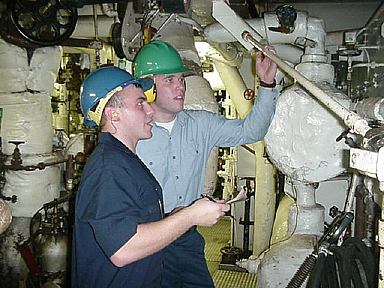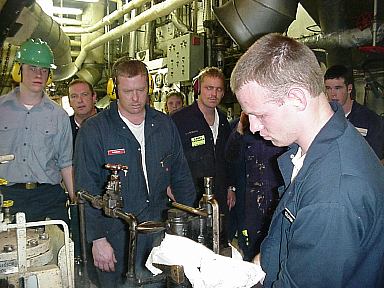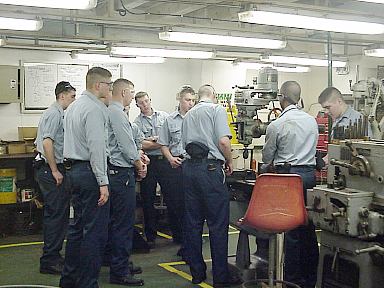
| January 2001 | ||||||
| Sun | Mon | Tue | Wed | Thu | Fri | Sat |
| 1 | 2 | 3 | 4 | 5 | 6 | |
| 7 | 8 | 9 | 10 | 11 | 12 | 13 |
| 14 | 15 | 16 | 17 | 18 | 19 | 20 |
| 21 | 22 | 23 | 24 | 25 | 26 | 27 |
| 28 | 29 | 30 | 31 | |||
At 0800 Atlantic Standard Time, 0700 Eastern Standard Time, and 1200Z, the Training Ship Empire State was moored in Willemstad, Curacao, taking various services and repairs from the pier. The weather, ditto Wednesday; air AND water temperature was 78 degrees Fahrenheit, skies were cloudy; winds were from the East at 02 knots; barometric pressure was 1016 millibars. Relative humidity was 70%. AND YOU KNOW...SHE WAS STILL THERE!
CAPTAIN'S LOG
We continue to beat a path between Empire State and the Curacao Drydock & Machine Corporation but as everyone already knows; a watched turbine never spins! However, that is insufficient cause to stem rabid curiosity or to quench the human need to hold the hand of an injured "shipmate".
While the professional machinists work their restorative magic ashore, life continues aboard Empire State. The engineers are taking full advantage of this unfortunate incident. Few had actually seen the inner workings of an operational turbine but that has certainly changed. Nearly everyone aboard has gone to the ER to see the Center of Earth's "Inertial" Force.
Scuttlebutt has it that some were seen performing ritualistic dances around the heartless turbine casing late last night. Initially, I thought that it was a curative rite but now I learn that the performers were returning from liberty, and actually want to stay here longer. We may never know the rest of that story.
The turbine repair has also become a convenient umbrella under which the radar technicians have taken refuge. Before we entered port, the radar failed to transmit and they took center stage. The heat was intently focused upon them for a short while, and just when they began to squirm, the turbine malfunctioned. That event fueled the rumor mill. The Engine room "Snipes" quickly blamed the "Twidgets", claiming that they had induced the turbine trouble as a sly way of shifting the focus away from themselves. We have a shipping number for the much needed repair parts so they have escaped scrutiny, albeit on the backs of the less fortunate. Intra-divisional rivalries abound and the competition is a healthy part of professional development. It is good for morale too.
We have been absolutely riveted to the turbine but that is but one piece of important equipment aboard this complex vessel. In this environment, if one believes that everything is fully operational, then he is at least five minutes behind the power curve. The Cadet engineers have established a real time maintenance plan that enables them to keep up, watch-to-watch. Trouble logs are strategically located throughout the ship. Each person aboard records any abnormality that he or she might discover and the engineers give these items prompt attention. The engineers remain current on equipment status but more important, frustration is greatly reduced.
The Engineers also maintain much larger auxiliary systems, as well. For example, most of the readers know that an Air Conditioning plant failed; no small matter when exterior temperatures are in the high eighties and when repair parts are miles away. But, the fault presented the opportunity to put academic theory into practice and the engineers seized upon it. They expertly repaired the unit and earned the gratitude and respect of many of their shipmates.
All are learning that an ounce of practice is worth a pound of theory.
Well folks, time for a management team meeting. We hold the meetings in the wardroom and if the agenda goes south, we can retreat to the bread locker, and take solace in one of Juvies fresh baked offerings. See You Tomorrow...and may the Inertial Force be with you, also.

Life in the Engine Room by CDR. T.M. Reilly, Engine Watch Officer (EWO)
Hello, from the 8-12 Engine Room Watch on the Empire State. We are a team of 24 cadets and 3 Engineering Watch Officers. This first leg of the 2001 MMA Winter Sea Term Cruise to Curacao has been busy, with lots of people in the engine room. Each morning, Second Engineer, LCDR Larry Jacobanis, with 3 boiler rates, 1/C Joe Scola, 1/C Ben Callard, and 1/C Oleg Novinski, blow soot from both boilers. LCDR Jacobanis also oversees the fuel oil transfer by the two fuel rates, 1/C Christopher Rooney, and 1/C Nicole Roy.
Captain Brad Lima and CDR Bruce Hartwell are in the engine room to conduct STCW proficiency assessments for those who are ready to be tested.(STCW is the maritime version of MCAS) We also have at least two classes of 10-15 students touring the engine room with professors CDR Arthur Aldrich and LCDR Tom Stanton. Routine maintenance is being done simultaneously, with the First Engineer CDR Paul Garbacik, and Cadet Chief 1/C Kevin Caldwell, leading their team. The Chief Engineer, Captain Bill Butler, starts and ends his typical 12-hour day with visits to our 8-12 watch, since we also work from 8 pm to 12 midnight. With so many people moving amongst the running equipment in the cramped engine room, all watchstanders must be vigilant and careful.
On January 17, while enroute to Curacao, 3/C Emily Hanks was making rounds of the spaces when she observed smoke coming from the control box for the outboard sanitary pump. 3/C Hanks, enroute to tell the Engineering Watch Officer, informed Electrical Rate, 1/C Pat Manning who proceeded to the scene and secured the power. With a CO2 fire extinguisher ready, CDR Reilly and 1/C Manning opened the door to the panel. The control power transformer had apparently overheated and melted the insulation, with no visible fire present. Electrical Engineer, LCDR Bill Laffin was summoned, and within a few hours, returned the pump to service. This is a perfect example of great teamwork, communication, and attention to detail. Both 1/C Manning and 3/C Hanks are commended for their prompt action and knowledge in handling this situation. Many thanks from the EWO on the 8-12.
A Special Hello to Dillon at Ridgely Elementary School

The Freshmen Perspective by 4/C Erin Derito (Brockton, MA)
Hi...My name is Erin Derito and I am a fourth class cadet this year on cruise! As a fourth class, I will try all the different majors while on cruise. In Division three, I have Marine Safety Environmental Protection first, and then deck and engine later. For the MSEP portion of cruise I have classes, labs and maintenance. In lab I learn and apply basic procedures such as working a microscope, collecting data and samples, and examining these samples and organisms.
In classes, we learn about some of the inhabitants of the ocean like phyto-plankton, zoo-plankton and bioluminescence. One of our classes teaches us how to don safety equipment properly and the appropriate situation to use it.
I will spend two weeks on the deck portion of cruise. In the classroom learning navigation, watch standing, and ship safety. I will also spend a couple of days on deck watch. On this watch, a fourth class is responsible for standing lookout, acting as a messenger, and making rounds. The upperclass are responsible for teaching us about the "navigational aids" while on watch. At the end of this portion of cruise I will be tested on my knowledge of the bridge and safety aspects of the ship. On the engine portion of cruise, I will have both classes and watch. While in class I will learn about the systems on the ship such as refrigeration, bilge, fuel oil, and so on. I will be tested on what I learn in class and during watch, by the upperclassmen. I like being a freshman on cruise because it gives me the opportunity to learn about the way that the ship is run and also to learn from my upperclass peers.

QUESTIONS FOR FRIDAY 26 JANUARY
MATH:
Five cadets went out to eat while in Curacao. They purchased pizza and soda. The pizza cost was 75.22 guilders (Nafl). The soda was 15.66 (Nafl). They shared the costs equally but had only US Currency with which to pay. How much did each pay if the rate of exchange was 1.77 (Nafl) to 1 US dollar?
SCIENCE:
General conditions of temperature, and precipitation for an area over a long period of time is called what.
GEOGRAPHY:
Name the seven countries that comprise Central America.
HISTORY:
The Central American country of Belize was known by a different name until 1973. What was the country previously called?
ANSWERS FOR THURSDAY 25 JANUARY
MATH:
$21.00 = $8.40 saving
$16.00 = $3.20 saving
$19.95 = $9.98 saving
Original Total price $56.95 - Total saving $21.58 = $35.37
Ms. Wickert paid $35.37 for the gifts.
SCIENCE:
Carbon Dioxide
GEOGRAPHY:
The Southern border is 08 degrees north of the equator. The Northern one is 11 degrees north of the equator.
HISTORY:
The first humans to inhabit many of the Caribbean Islands were the Arawak Indians.